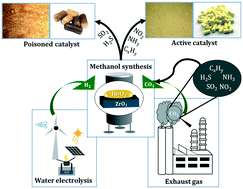Influence of gas impurities on the hydrogenation of CO2 to methanol using indium-based catalysts†
Abstract
In this study, the performance of an In2O3/ZrO2 catalyst for hydrogenation of CO2 to methanol is reported in the presence of typical impurities of industrial CO2 feed gas streams. Experiments were performed with defined amounts of SO2, H2S, NO2, NH3 and hydrocarbons purposely added to the reaction mixture under industrially relevant conditions (225–275 °C, 50 bar total pressure, H2 : CO2 = 3 : 1). Comparative studies – with and without added impurities – further relate the observed effects to the behaviour of the commercial Cu/ZnO/Al2O3 methanol catalyst under identical treatments. Elemental analysis was used to determine the amount of sulphur, nitrogen and carbon residing on the catalyst after poisoning and after methanol synthesis. Moreover, temperature programmed desorption (TPD), temperature programmed reduction (TPR) and X-ray photoelectron spectroscopy (XPS) allowed identifying potential catalyst poisons formed on the catalyst surface. This work discloses that H2S and SO2 impurities led to drastic deactivation of the In2O3/ZrO2 catalyst (due to indium sulfide and -sulphate formation), while NH3, NO2 and hydrocarbon impurities have no major effect on the methanol production.



 Please wait while we load your content...
Please wait while we load your content...